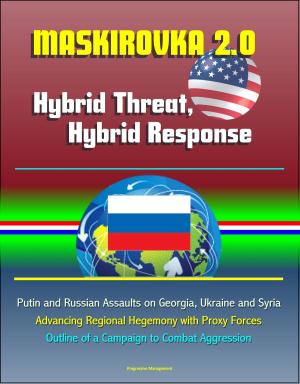Safe School Initiative, Prevention of School Attacks, Columbine High School Report on Emergency Response, Presidential Report on the Virginia Tech Tragedy, School Shooter Threat Assessment
Nonfiction, Social & Cultural Studies, Political Science, Politics, Law Enforcement| Author: | Progressive Management | ISBN: | 9781301515080 |
| Publisher: | Progressive Management | Publication: | May 2, 2013 |
| Imprint: | Smashwords Edition | Language: | English |
| Author: | Progressive Management |
| ISBN: | 9781301515080 |
| Publisher: | Progressive Management |
| Publication: | May 2, 2013 |
| Imprint: | Smashwords Edition |
| Language: | English |
School safety and the attacks at Columbine High School and Virginia Tech are the subjects of four major government reports reproduced in this important ebook.
Safe School Initiative: Littleton, Colorado; Springfield, Oregon; West Paducah, Kentucky; Jonesboro, Arkansas. These communities have become familiar to many Americans as the locations where school shootings have occurred in recent years. School shootings are a rare, but significant, component of school violence in America. In June 1999, following the attack at Columbine High School, our two agencies-the U.S. Secret Service and the U.S. Department of Education-launched a collaborative effort to begin to answer these questions. The result was the Safe School Initiative, an extensive examination of 37 incidents of targeted school shootings and school attacks that have occurred in the United States beginning with the earliest identified incident in 1974 through June 2000.
Wanton Violence at Columbine High School: This report is an analysis of the fire service and emergency medical service (EMS) operations and the overall response to the assault on Columbine High School at Littleton, Colorado, on April 20, 1999. Incident command, special operations, and mass casualty emergency medical services are featured. In any major incident, the efforts of all public safety personnel are inexorably linked. However, this report does not address the overall law enforcement operations, or the concurrent operations of various police commands, the special weapons and tactics (SWAT) teams, or the explosive ordnance disposal (EOD) units. The Jefferson County Sheriff's Office issued a formal report and has released surveillance video and radio transmissions that provide additional information on law enforcement's efforts during this incident.
Virginia Tech: On April 21, 2007, in response to the tragic shootings at Virginia Tech, President George W. Bush directed Secretaries Michael Leavitt and Margaret Spellings and Attorney General Alberto Gonzales to travel to communities across our nation and to meet with educators, mental health experts, law enforcement and state and local officials to discuss the broader issues raised by this tragedy. Questions were raised about the proper balance between providing for the safety and security of our communities, while protecting privacy and liberty, and helping people with mental illness get the care they need. Our meetings and this report were not, and could not be, an attempt to resolve or reset the balance of all these interests. Nor did people with whom we met feel we could eliminate all risk, and at the same time maintain a free and open society. But there was a shared sense that we must not miss the opportunity to learn from this event and do what we can to make our communities safer.
School Shooter: Why would a student bring a weapon to school and without any explicable reason open fire on fellow students and teachers? Are school shooters angry? Are they crazy? Is their motive revenge? Hatred for the victims? A hunger for attention? The origins of human violence are complex. NCAVC's Study and the Leesburg Symposium * The School Shooter Phenomenon and Threat Assessment * Misinformation About School Shootings * Chapter II * Assessing Threats * What is a Threat * Motivation Signposts * Types of Threats * Factors in Threat Assessment * Levels of Risk * Chapter III * Four-Pronged Assessment Approach * The Four-Pronged Assessment Model * Personality of the Student * Family Dynamics * School Dynamics * Social Dynamics * Chapter IV * Findings * Prong One: Personality Traits and Behavior * Prong Two: Family Dynamics * Prong Three: School Dynamics * Prong Four: Social Dynamics * Chapter V * The Intervention Process * Threat Management In Schools * The Role of Law Enforcement * Examples of Threats * Low-Level Threat * Medium-Level Threat * High-Level Threat * Chapter VI * Recommendations and Conclusions
School safety and the attacks at Columbine High School and Virginia Tech are the subjects of four major government reports reproduced in this important ebook.
Safe School Initiative: Littleton, Colorado; Springfield, Oregon; West Paducah, Kentucky; Jonesboro, Arkansas. These communities have become familiar to many Americans as the locations where school shootings have occurred in recent years. School shootings are a rare, but significant, component of school violence in America. In June 1999, following the attack at Columbine High School, our two agencies-the U.S. Secret Service and the U.S. Department of Education-launched a collaborative effort to begin to answer these questions. The result was the Safe School Initiative, an extensive examination of 37 incidents of targeted school shootings and school attacks that have occurred in the United States beginning with the earliest identified incident in 1974 through June 2000.
Wanton Violence at Columbine High School: This report is an analysis of the fire service and emergency medical service (EMS) operations and the overall response to the assault on Columbine High School at Littleton, Colorado, on April 20, 1999. Incident command, special operations, and mass casualty emergency medical services are featured. In any major incident, the efforts of all public safety personnel are inexorably linked. However, this report does not address the overall law enforcement operations, or the concurrent operations of various police commands, the special weapons and tactics (SWAT) teams, or the explosive ordnance disposal (EOD) units. The Jefferson County Sheriff's Office issued a formal report and has released surveillance video and radio transmissions that provide additional information on law enforcement's efforts during this incident.
Virginia Tech: On April 21, 2007, in response to the tragic shootings at Virginia Tech, President George W. Bush directed Secretaries Michael Leavitt and Margaret Spellings and Attorney General Alberto Gonzales to travel to communities across our nation and to meet with educators, mental health experts, law enforcement and state and local officials to discuss the broader issues raised by this tragedy. Questions were raised about the proper balance between providing for the safety and security of our communities, while protecting privacy and liberty, and helping people with mental illness get the care they need. Our meetings and this report were not, and could not be, an attempt to resolve or reset the balance of all these interests. Nor did people with whom we met feel we could eliminate all risk, and at the same time maintain a free and open society. But there was a shared sense that we must not miss the opportunity to learn from this event and do what we can to make our communities safer.
School Shooter: Why would a student bring a weapon to school and without any explicable reason open fire on fellow students and teachers? Are school shooters angry? Are they crazy? Is their motive revenge? Hatred for the victims? A hunger for attention? The origins of human violence are complex. NCAVC's Study and the Leesburg Symposium * The School Shooter Phenomenon and Threat Assessment * Misinformation About School Shootings * Chapter II * Assessing Threats * What is a Threat * Motivation Signposts * Types of Threats * Factors in Threat Assessment * Levels of Risk * Chapter III * Four-Pronged Assessment Approach * The Four-Pronged Assessment Model * Personality of the Student * Family Dynamics * School Dynamics * Social Dynamics * Chapter IV * Findings * Prong One: Personality Traits and Behavior * Prong Two: Family Dynamics * Prong Three: School Dynamics * Prong Four: Social Dynamics * Chapter V * The Intervention Process * Threat Management In Schools * The Role of Law Enforcement * Examples of Threats * Low-Level Threat * Medium-Level Threat * High-Level Threat * Chapter VI * Recommendations and Conclusions















